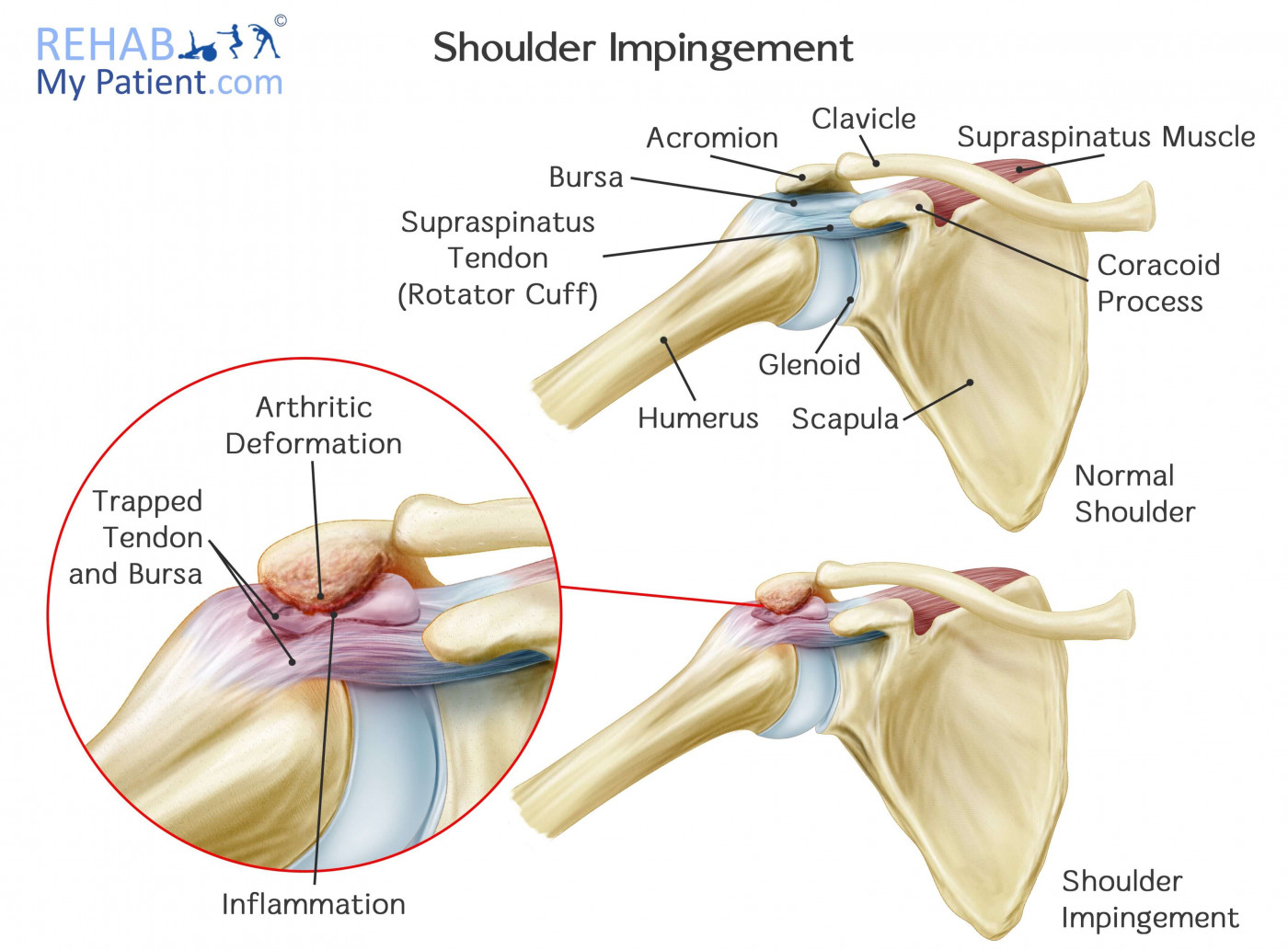Shoulder Impingement Syndrome
Opublikowano dnia 25th Jun 2017 / Opublikowano w: Ramię

Shoulder impingement syndrome is a very common shoulder problem that causes a pinching of one of the tendons in the shoulder.
It tends to occur commonly within the shoulders of the over 50s, although not exclusively, and can occur in younger patients but is rarely seen below the age of 30.
When injuries to the rotator cuff tendons occur, the tendon responds by swelling similar to the way ankles do when they are sprained. Since the rotator cuff muscle is surrounded by bone, the swelling can cause numerous events to occur. As the tendon swells, there is not much space under the bone at the top of the shoulder blade, and when lifting your arm, the tendon can catch or impinge under the bone. This causes scratching or inflammation to the tendon, resulting in more swelling. The more the tendon swells, the less space there is for the tendon to move, and the impingement becomes worse, causing more swelling, and resulting in a complicated vicious circle that can take months or even years to resolve.
Shoulder Anatomy with Relevance to Impingement
The main shoulder joint, the glenohumeral joint, is rarely affected. This condition affects the smaller joint in the shoulder known as the acromioclavicular joint, or ACJ for short. The ACJ is the articulation between the collar bone and the top of the shoulder blade (known as the acromion). If you look at your shoulder, you will notice a small tip or protrusion at the top… this is the acromion (Greek akron = tip/hill).
There are four rotator cuff tendons, but the most commonly affected is called the supraspinatus tendon. The supraspinatus is a muscle that stabilizes the shoulder joint. It also helps to lift your arm to the side. AS you lift your arm, the tendon slides under the acromion. This is where the problems occur, as the tendon can become pinched (or impinged) under the acromion/ACJ.
There is also a bursa between the tendon and the ACJ, known as the subacromial bursa. This can become inflamed which swells and is known as bursitis. This reduces the space even more and causes impingement as well.

What Causes Shoulder Impingement?
There are a number of causes of shoulder impingement:
- Arthritis of the ACJ
Wear and tear on the ACJ can cause something known as hypertrophy which is thickening of the joint. There could also be bone spurs. This decreases the space under the joint and can cause impingement of the rotator cuff tendon.
- Low-lying Acromion
A low lying or hooked acromion can decrease the space underneath the ACJ and cause impingement of the rotator cuff tendon. Often classified in three grades, I II and III. Grades II and III can be surgical cases.
- Bursitis
Subacromial bursitis is a swelling of the fluid filled sac under the ACJ and if this becomes inflamed, there is less space for the rotator cuff tendon causing impingement.
- Poor Posture
Poor posture puts the shoulders forwards and elevates the shoulder blade which can cause impingement.
- Repetitive strain to the tendon
Repeated pressure and use (e.g. in golfers, or other sports people) can cause inflammation of the rotator cuff tendon (known as tendinopathy). This causes swelling, and then impingement.
- Rotator Cuff Tear
If the rotator cuff tendon weakens enough through impingement, it can tear causing a partial thickness or full thickness rotator cuff tear.
How to Treat Impingement Syndrome:
- Anti-Inflammatory Medication
An anti-inflammatory medication is one of the most common forms of treatment for this condition. Consistently taking the medication for close to eight weeks will help in effectively treating the condition. Taking an anti-inflammatory for a short time period can help to relieve pain, but it isn’t going to rectify the underlying problem. If one anti-inflammatory medication doesn’t work within 10-14 days, a different one might need to be used. However, caution should be advised because shoulder impingement is a chronic condition typically lasting 6-12 months, so look for more natural alternatives such as ice and heat.
- Daily Stretching
Daily stretching exercises are beneficial. Your therapist will guide you.
- Cortisone Injections
If you still have persistent symptoms beyond using an anti-inflammatory medication, cortisone injections into the area might be needed. Cortisone is a strong anti-inflammatory that only needs to be used when dealing with a serious instance resulting in weakening of the muscle tendon tissues.
- ICE ICE ICE
Place an ice bag on the tip of the shoulder and do this every day for 4-6 weeks. It takes a long time but shoulder impingement is hard to shift, so doing the ice will help. Ask your therapist how long to use the ice for. If ice doesn’t help, try heat.
- Therapy
Seek help from a physiotherapist, osteopath, chiropractor or other manual therapist because these problems are stubborn and take a lot of therapy to get them to disappear. Without treatment, there is a possibility you will have further problems.
Tips:
- Impingement often results from sports that place an undue amount of stress on the shoulder.
- The condition tends to develop more often in those who are aged 30 or older.
- Warehouse workers, assembly-line workers and athletes are at an increased risk of developing an impingement.
- Osteoarthritis, bone spurs and degenerative disease tend to leave individuals more susceptible to the condition.
- Avoid sleeping with your arm raised above your head at night, or on the affected side.
Zapisać się
Zarejestruj się już teraz, aby skorzystać z bezpłatnego okresu próbnego!
Zacznij korzystać z Rehab My Patient już dziś i zrewolucjonizuj proces przepisywania ćwiczeń, aby zapewnić sobie skuteczną rehabilitację.
Rozpocznij 14-dniowy bezpłatny okres próbny